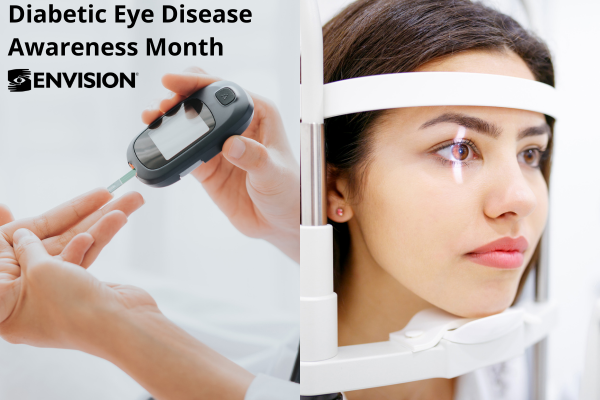Eyes on Diabetes: A Closer Look at Diabetic Eye Disease Complications
By Beth Walker • Nov 07, 2023
.png?lang=en-US&ext=.png)
Blog Content
Diabetic Retinopathy: The Silent Threat
Imagine high blood sugar waging war on the delicate vessels in your eyes. This is the reality for those with
Diabetic Retinopathy, a leading cause of blindness among working-age adults. These destructive blood vessels can swell, leak, and obstruct blood flow, leading to blurred vision and, in severe cases, blindness. Diabetic Retinopathy often affects both eyes, and early symptoms might go unnoticed. The longer diabetes lingers, the greater the risk. Recognizing the signs, such as blurry vision, the emergence of dark shapes, difficulty distinguishing colors, or encountering dark voids in your sight, is crucial. The good news? Diabetic Retinopathy is treatable, with early detection through a yearly dilated eye exam offering the best chance for successful treatment.
Macular Edema: The Hidden Culprit
Macular Edema, a visual impairment often associated with Diabetic Retinopathy, can also stem from other sources like Macular Degeneration, Retinal Vein Occlusion, medication, eye tumors, or surgery. It can strike during the early or late stages of Diabetic Retinopathy but is more prevalent in the latter. This impairment distorts vision by causing the macula, a critical area near the center of the retina, to swell. Macular Edema is the leading cause of blindness among those with Diabetic Retinopathy. Recognizable symptoms include distorted central vision, faded or altered colors, and difficulties in reading. Fortunately, various treatment options exist to combat Macular Edema and help safeguard your sight.
Cataracts: The Cloudy Puzzle
Cataracts, though commonly developed in people aged 80 and older, are not merely a result of aging. They can also develop due to eye injuries, glaucoma, and diabetes. This visual impairment develops as proteins in the eye lens break down and clump together, causing cloudiness. Symptoms include blurred or cloudy vision, faded colors, difficulty seeing at night, glare from fluorescent lighting, double vision, or the appearance of halos around lights. Elevated sugar and glucose levels associated with diabetes can promote cataract development. Surgery can remove cataracts, but it's not always an immediate necessity. There are alternative options to manage symptoms and maintain your vision, but the key is managing your blood sugar and regular eye check-ups.
Glaucoma: The Stealthy Thief of Sight
Stealing vision with stealth, Glaucoma affects more than three million Americans, thanks to elevated pressure within the eye. High pressure can damage the optic nerve and lead to vision loss. With various types of Glaucoma, including Open-Angle and Angle-Closure, the symptoms can vary widely. They might include severe eye pain, a gritty sensation, nausea, headaches, blurred vision, or even vision loss. In some cases, symptoms remain dormant or emerge late. Early detection through regular eye exams is crucial. Thankfully, multiple treatment options are available to preserve remaining vision.
As we honor National Diabetic Eye Disease Awareness Month, let's continue to delve into the intricate world where diabetes and vision loss intersect. By understanding the risks and taking proactive steps, we empower ourselves and others to protect vision and health.
If you are seeking low vision rehabilitative services, please visit our Vision Rehabilitation Center in Wichita or Dallas. If you are seeking support and community with other people experiencing vision loss, please visit our adult and youth programs pages.